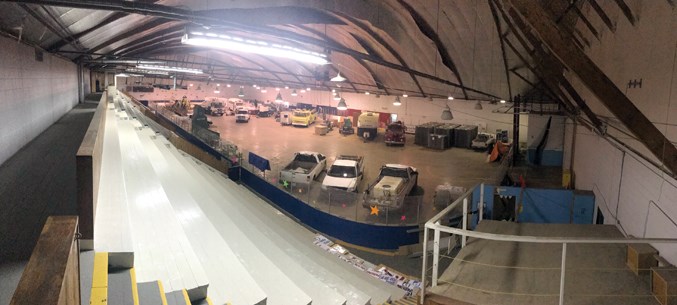The clock is ticking on Jubilee Arena, which hosted its final hockey game in 2012, but was spared demolition after asbestos was found throughout.
But when the 55-year-old facility will meet the wrecking ball and how much it will cost to not only raze it, but pave the site, are questions town councillors want answered before making a final decision.
Following a 4-0 vote by councillors at their Nov. 13 committee of the whole meeting, administration was tasked to provide more information during upcoming budget deliberations on demolishing the facility. Councillors David Truckey, Murtaza Jamaly and Clem Fagnan were absent.
“It’s important to recognize that as a community we made the decision to build the Spirit Centre and the plan all along was to demolish it and put in a parking lot. And we’ve seen at many events held there that the current parking lot is not adequate in size,” said mayor Ralph Leriger.
“This is a problem we’ve somewhat turned our back on for the last four years — certainly there were things that were more urgent and required our attention. But now that the ceiling is falling off in chunks and it’s no longer feasible to have our summer crews stage in there, the urgency takes on a different perspective.”
Jubilee Arena was supposed to be levelled in 2012, but those plans were shelved following the discovery of asbestos. That same year then-mayor Bruce Lennon said they had budgeted $200,000-$300,000 for the demolition — a figure that didn’t include dealing with asbestos — so the facility was left standing.
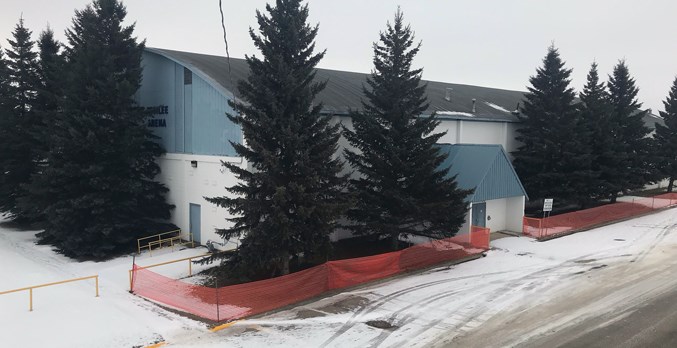 A view of Jubilee Arena today from the stands of Keller Field.
A view of Jubilee Arena today from the stands of Keller Field.
CAO Dwight Dibben told council they were able to dig up a 2012 report that stated 16 of 26 building-material samples tested positive for asbestos. There were no demolition costs provided in that document and Dibben doubts there’s any additional government funding available to help pay for a demolition.
“Based on the analysis that was done we do know that not just in the building blocks, but also in other finishing materials, there is hazardous materials,” said Dibben. “And therefore the refurbishment estimate would be a very conservative estimate.”
Fueling council’s discussion was a five-page MPE Engineering assessment of Jubilee delivered to director of development services Simone Wiley in July.
Councillors showed little appetite to continue using Jubilee as a repository as the report lists 12 recommendations with an approximate $1,000,000 price tag to make it usable for warm storage — top of the list is $430,000 to remove the failing ceiling panels and insulate the building, followed by $240,000 to replace all the existing lights with LEDs.
Using the building as cold-storage, which would still include work to the ceiling, would probably trim the costs, said Wiley, noting there will still be ongoing operating and maintenance costs if they keep it.
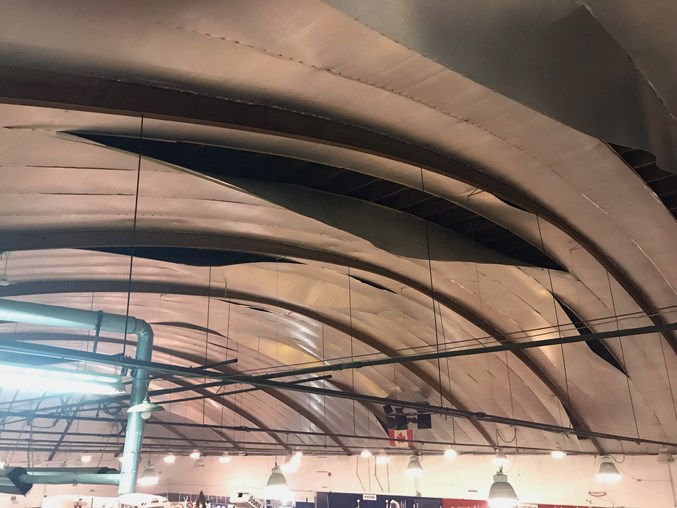 The majority of reflective ceiling panels are failing and will need to be removed if the facility is to be used for storage.
The majority of reflective ceiling panels are failing and will need to be removed if the facility is to be used for storage.
“If it’s going to cost us $700(thousand), $750(thousand) just to refurbish it, then why not spend the extra $150(thousand) and get rid of it and the problem is solved,” said Coun. John Shoemaker.
“I know everyone needs storage, but when you have excess storage it allows you the ability to become a bit of a hoarder. I would not be in favour of filling it up with our junk over the next 10 or 20 years. If stuff needs replacing then the stuff we’re replacing needs to go to auction, not storage,” added Leriger. “So we need to decide how many vintage fire trucks we want to keep and what we’re going to do with them and the rest of the stuff in there.”
The MPE report also poses a $900,000 estimate for demolition, although Leriger called it a “best guess” and noted it doesn’t include landscaping costs.
“If we’re going to make decisions, we need to make decisions based on real numbers, or as close as we can get,” said Leriger. “I mean it’s asbestos, it’s not nuclear waste, so it’s manageable. They do asbestos-abatement projects all over the place and it can be dealt with. I participated in the largest asbestos abatement project in Canada at the time when we tore down the Wabamun power plant and it’s manageable.
“I’ve looked and looked and looked at different ideas related to our ag society, related to the track and what we could repurpose that building for and I haven’t come up with any brainwaves … certainly nothing that would justify spending the kind of the money that is being reported.”
The history of Jubilee
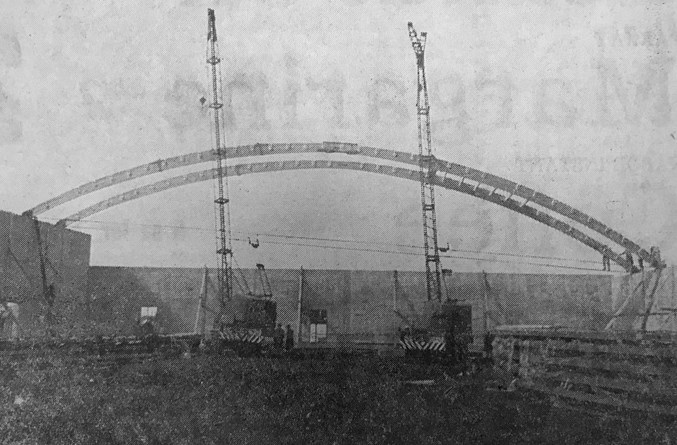 Crews install two of the 10 arches that supported the roof during construction in April 1963. Made in New Westminster, B.C. the arches each weigh four tons and cost $1,225 each to install.
Crews install two of the 10 arches that supported the roof during construction in April 1963. Made in New Westminster, B.C. the arches each weigh four tons and cost $1,225 each to install.
According to back issues of the Westlock News, 1,500 people attended the official grand opening of the Westlock and District Jubilee Family Recreation Centre on July 13, 1963 — by the end of the year the News referred to it simply as Jubilee Arena.
The arena was one of a handful of major builds in the community from 1962-1964 which saw the construction of the current county administration building, the auxiliary hospital and St. Mary School.
Leading up to the opening the Rotary Spirit Centre in 2012, long-time resident George Brost, recalled the grade beam was put into the ground before freeze-up in the fall of 1962, while the structural concrete was poured and then cured over the winter.
The project was initiated by the Westlock and District Chamber of Commerce, then taken up by a dedicated committee.
“There was a horse barn there; they heated that up in the wintertime and they pre-fabbed all the pilasters (structural concrete) in there,” said Brost in 2012.
The pilasters were poured three or four at a time in the barn, left long enough to properly cure, then pulled outside so the process could be repeated until they were all done.
“In the summer time they put the pilasters up, built the walls and put the roof on it,” Brost recalled.
“But most of it was done as a winter-works project. Most of the buildings at that time were constructed with (federal) winter-works projects because they were cheaper; there wasn’t much else for work in those days.”
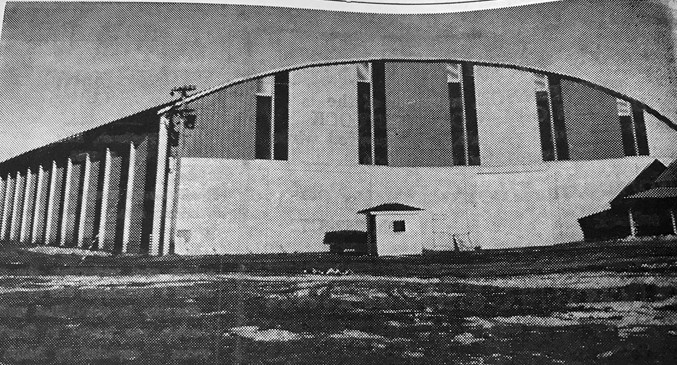 A photo the north side of Jubilee Arena from 1964.
A photo the north side of Jubilee Arena from 1964.
The first hockey game at the rink, which was played on natural ice, was on Dec. 29, 1963.
The night the Westlock Generals, the community’s first senior hockey team in a decade, lost 17-6 to the St. Albert Comets in a Sturgeon Hockey League tilt — the league also counted teams in Vimy, Legal, Morinville and Redwater.
An ad in the Nov. 7, 1962 Westlock News says the facility would be paid for by a provincial government recreation grant of $20,000, a federal government winter-works grant of $21,000 and $60,000 in community fundraising — by 1964 a little over $35,000 had been raised by local donations.
Leading up to a Nov. 3 1964 plebiscite as to whether to proceed with Phase 2, which would have seen the addition of an 84’ x 42’ heated outdoor pool, plus a two-storey 220’ by 24’ addition to the west side, it was reported Jubilee cost $75,744 to build — $5,000 of that bill remained unpaid at the time, while the yearly operating deficit was $373.
According to www.inflationcalculator.ca, $75,744 would equal $631,676.38 in 2018.
The plebiscite, which failed by 11.8 per cent (only 54.8 per cent of residents voted ‘yes’, which was under the 66 per cent bar), would have seen the town debenture $90,000 over 20 years to build the second phase. In total, just under 67 per cent of the eligible voters of the day, 590 residents, cast ballots.
Interestingly, 69.9 per cent of residents did vote ‘yes’ that same day to create a municipal library.
